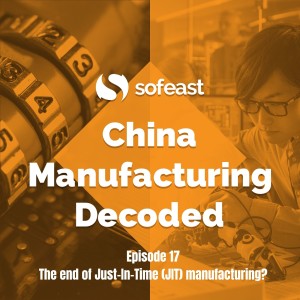
A lot of commentators are discussing what's going to happen to the manufacturing industry 'post-COVID19,' in fact, we've discussed it ourselves before here!
But one topic keeps coming up, JIT manufacturing and how it has been negatively affected by the virus and other circumstances.
So, let's explore this supply chain model - why has it been so popular, how has it come under strain this year, and what's next for importers who currently use it?
Show NotesStart to 1:31 - Introduction
1:31 to 11:22 - Some examples of what JIT is and what it isn't. Discussing the dangers of holding too much inventory, especially where risk and working capital is concerned, and long supply chains.
11:22 to 12:51 - 3 benefits of JIT: Lower working capital, ability to be more responsive to the market by accelerating production of good sellers rapidly, and the ability to cut losses on poor sellers and halt production quickly in order not to hold stock of them.
12:51 to 16:00 - Why JIT (Just In Time) Manufacturing works well with a short supply chain with fast processing times, such as automakers.
16:00 to 23:05 - How and why is JIT susceptible to external circumstances, such as the coronavirus pandemic. Is it even JIT's fault that disruption from the outside can happen, or is it actually your supply chain's setup?
23:05 to END - What's the scope for things to get 'back to normal' or will there be lasting changing to the way supply chains are structured? The role of the US/China trade war in spurring change in, specifically, American companies.
Get in touch with us- Connect with us on LinkedIn
- Send us a tweet @sofeast
- Prefer Facebook? Check us out on FB
- Contact us via Sofeast's contact page
- Visit our website at Sofeast.com
- Subscribe to our YouTube channel
More Episodes
 2024-11-01
2024-11-01
 76
76
 2024-10-25
2024-10-25
 81
81
 2024-10-11
2024-10-11
 94
94
 2024-09-20
2024-09-20
 82
82
 2024-09-13
2024-09-13
 79
79
 2024-08-23
2024-08-23
 98
98
 2024-08-16
2024-08-16
 102
102
 2024-07-05
2024-07-05
 101
101
 2024-06-28
2024-06-28
 172
172
Create your
podcast in
minutes
- Full-featured podcast site
- Unlimited storage and bandwidth
- Comprehensive podcast stats
- Distribute to Apple Podcasts, Spotify, and more
- Make money with your podcast
It is Free
- Privacy Policy
- Cookie Policy
- Terms of Use
- Consent Preferences
- Copyright © 2015-2024 Podbean.com






